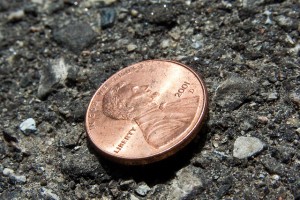The following post is part 3 in a 4 part series:
“How to Be Wealthy: The ABC’s of Building Wealth.“
Part 3 (this post) is about stewardship and how it can help you build wealth.
What is stewardship?
In part 1 of our series on building wealth, I said that to learn how to be wealthy you need to learn good stewardship.
But many of you might be asking, what is stewardship, exactly?
According to Dictionary.com a steward is…
A person who administers the property, house, finances, etc. of another.
In other words, you aren’t the owner, but merely a manager. A perfect example would be the manager of a business.
The manager doesn’t own the business, but practices stewardship over the business through budgeting, marketing, product development, and paying the debts on time (unlike Frank in the funny E*TRADE commercial below).
Now that you understand stewardship, let’s talk about how to build wealth through practicing stewardship.
Stewardship in 5 Steps
1. Practice stewardship by acknowledging that you are not the owner
I touched briefly on this in part 1 of this series, but let me tell you a short story I read once that will help illustrate this point as it relates to stewardship.
“Suppose someone passes empty-handed through the turnstiles at a big city art museum and begins to take the pictures off the wall and carry them importantly under his arm.
You come up to him and say, “What are you doing?”
He answers, “I’m becoming an art collector.”
“But they’re not really yours,” you say, “and besides they won’t let you out with those. You’ll have to go out just like you came in.”
But he answers again, “Sure they’re mine. I’ve got them under my arm. People look at me as an important dealer in the halls. And I don’t bother myself with thoughts about leaving. Don’t be a kill joy.”
Would you call this man a fool?
I sure would. Yet, this is exactly what many of us do when we don’t practice good stewardship.
It doesn’t matter if you are Bill Gates, Mother Theresa, or that guy you saw while walking down the street this morning, all of your “stuff” ends up in the same place when you’re gone…in someone else’s hands.
Or, as the old saying goes, “There are no U-Hauls behind hearses.”
2. Practice stewardship by giving away a portion of your income
We talked a lot about giving in part 2 of this series, so I won’t go into much more detail here.
Just know that unless you give away a portion of your income, you’ll find it very hard to practice good stewardship.
3. Practice stewardship by spending less than you earn
You wake up one morning and you realize your car needs gas. The gas tank holds 10 gallons.
You go to the gas station, fill up your tank, and drive away.
Now, how much gas can you use before you end up stranded on the side of the highway?
If you said “less than 10 gallons,” CONGRATULATIONS! You understand how to spend less than you earn.
It really is that simple…in principle anyway!
The easiest way to practice good stewardship and spend less than you earn is by putting together the “b” word (i.e. budget) for your finances.
Or a spending plan, as I like to call it.
Can you imagine the manager of a business not keeping track of the accounting (i.e. what the business made and what it spent) Of course not!
You see, the idea is to get a handle on where you’re spending your money (every penny!) so you can know where and when to cut back as well as where and when to splurge a little.
You can then take an honest look at whether or not you’re making wise spending decisions.
If you don’t create a spending plan, though, stewardship will never happen, so practice good stewardship and plan out your expenses.
We’ll talk about some great tools (i.e. Mvelopes.com, Mint.com, etc.) that will help you do this in a future post.
But for now I don’t care how you do it, just do it!
4. Practice stewardship by eliminating and minimizing the use of debt
Seems like another no-brainer right?
Wrong!
In America, debt is like a rite of passage. If you don’t have some form of debt, then you’re “un-American.”
At least that’s what you’d think if you took a look at the numbers in this online calculator (those numbers don’t even include debt held by you and me, i.e. consumer debt).
Look, debt CAN be a valuable tool when used wisely.
For example, a mortgage for the purchase of a home that is within your means CAN be a wise use of debt.
On the other hand, a loan for a $40,000 gas guzzling 4×4 SUV that gets 15 miles per gallon is NOT a wise use of debt.
“But I need it to haul my boat on the weekends!” you say?
Look, if you can’t afford to pay cash for a car, then you can’t afford a boat…and you just proved my point!
5. Practice stewardship by saving and investing for the future
Do you own an umbrella?
Really?
Does it rain every day (if you live in Seattle, just pretend you don’t and say “no”)?
Oh, it doesn’t?
So you own an umbrella on the off chance that it might rain someday and you’ll need it to keep dry and stop the rain from potentially ruining your plans?
If you answered yes to that last question, then I don’t need to spend time convincing you why it’s important to save for the unexpected (and expected!) expenses that pop up from time to time.
I’ve said it before and I’ll say it again, when it comes to your finances, at some point it’s going to rain. And when it rains, it usually pours!
I’ll wait for part 4 of this series to tell you the “how much” and “what for” when it comes to saving, but for now just know that good stewardship means saving and investing a little bit of money for the future.
Stewardship in Summary
Well, there they are, the 5 steps of practicing good stewardship with your money.
During our next post, we’ll talk about saving and investing for the future–how much to save, what to save for, and where to put your savings.
In the mean time, if you enjoyed this post on stewardship, don’t forget to sign up to get our future blog posts, videos, and money saving tips delivered straight to your inbox by using the sign up forms at either the top or bottom of this page!

